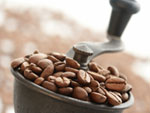|

Back to Coffee Basics
Grinding
The effect on quality of using freshly ground coffee in preparing your beverage
can not be overstated. Coffee is, in essence, a spice. The flavor is nicely
tucked away, safely, inside the freshly roasted bean.
As soon as the bean is ground, the surface area of the coffee that is exposed
to the air increases exponentially. This makes it ideal for brewing, but also
ideal for “staling”. For most coffee drinkers, some staling is
acceptable. Many coffee lovers will grind their beans just before heading off
to bed, setting the timer on the brewing device so that they wake to the aroma
of the java that starts their day.
And this is certainly head and shoulders above using a pre-ground commercial
coffee.
And then there are the newer devices, by Cuisinart and Capresso, that allow
the consumer to place whole bean coffee in the device the night before, and
wake to fresh ground, fresh brewed coffee. Very little “staling“ occurs
overnight, as the beans remain in whole form until moments before grinding
and brewing occurs almost immediately after grinding.
I know many folks that love their “Grind and Brew” type machines,
but they are a little pricey when you consider the cost of a grinder.
 Coffee Grinders come primarily in two types – blade and burr. Blade
grinders are less expensive, and perfectly acceptable for use in grinding for
drip coffees, if used properly. They can be found for as little as $10 in some
of the “big box” type stores. The main shortcoming of a blade grinder
is the buildup of heat caused by the friction of the blade against the beans. Since drip coffees do not have to be ground especially fine, this is not much
of a concern. These grinders are not really capable of producing the very fine
grind needed for espresso preparation. Coffee Grinders come primarily in two types – blade and burr. Blade
grinders are less expensive, and perfectly acceptable for use in grinding for
drip coffees, if used properly. They can be found for as little as $10 in some
of the “big box” type stores. The main shortcoming of a blade grinder
is the buildup of heat caused by the friction of the blade against the beans. Since drip coffees do not have to be ground especially fine, this is not much
of a concern. These grinders are not really capable of producing the very fine
grind needed for espresso preparation.
Burr grinders operate on a different principle. The coffee beans are forced
between two machined “burrs” that are similar to meshed gears.
The distance between the two burrs defines how coarse or fine the coffee is
ground. This allows the burr grinders to offer a consistency of grind that
requires virtually no skill on the part of the person grinding. They also produce
much less heat than blade grinders.
I have seen burr grinders available for as little as $40 in a “big box” store.
This would be a perfectly fine grinder for use in drip grind machines. A good
espresso grinder will start at around $200.
The coarseness of the grind should be a match to the type of brewing preparation
being used. At one end of the scale is the espresso and Turkish coffee grind,
which is very fine, and almost powdery. At the other end is the large, flaky
grind found in many commercial canned coffees, suitable for large brewing urns
and percolators. In the middle lives the correct grind for “pourover” brewing
devices – the “Mr. Coffee” type device found in the majority
of American homes. The cone type filters want a grind slightly finer than the
flat bottom filters.
Some of this is, admittedly, trial and error, and one of the best ways to
get good at grinding for your specific device is to ask your roaster to provide
you with a sample of coffee ground to the correct consistency for the type
of machine you use, then using that sample as a visual guideline. Turtle Creek
Coffee is happy to provide such samples for its customers upon request.
[ Back to Coffee Basics ]
Remember, we are roasting right now, so don’t hesitate to call Mick at 803-361-6425,
or e-mail using
the Contact Us link, and try our fine coffee right
away.
|





